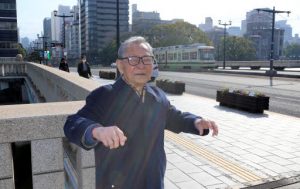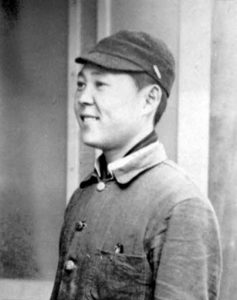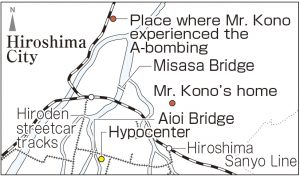Survivors’ Stories: Akito Kono, 91, Hiroshima: “Where there is love, there is no war”
Feb. 4, 2019
by Yuji Yamamoto, Staff Writer
Standing on the Aioi Bridge in Naka Ward, Hiroshima, Akito Kono, 91, says repeatedly, “It’s difficult for me to be here.” He recalls his sad memory from the bridge that took place as he was hurrying home on the day of the atomic bombing and says emphatically, “Where there is love, there is no war.” His gentle eyes fill with tears.
Back in 1945, Mr. Kono was 18 years old and a second-year student at Hiroshima Denki School (now Hiroshima Kokusai Gakuin High School). The year before, his family received news that his father, Uichi, had been killed in action in Luzon, the Philippines. After that, Mr. Kono lived with anxiety, not knowing how to protect his family in the role of eldest son.
On the morning of August 6, Mr. Kono was mobilized to work for the war effort at a warehouse in Nagatsuka, Gion-cho (now part of Asaminami Ward). He helped store foods there, such as rice and soy sauce, for the army and send them out to army units. He went to work by bicycle from his home in Ushita-cho (now part of Higashi Ward). After changing in clothes and sitting down in a chair, he was suddenly bathed in a flash of light.
Although the warehouse was located 4.1 kilometers from the hypocenter, he was blown about four or fives meters by the blast. He then ran to the air-raid shelter behind the building, but it was already crammed with people so he took refuge at a nearby mountain. When he looked out at the central part of the city, he saw that it was engulfed in flames. He feared for the safety of his family, but he was unable to go home right away.
When the raging fires began to abate that evening, he went back down the mountain. Misasa Bridge, which he had crossed that morning, was now bent into a dog-leg shape, forcing him to take a roundabout way south. The scene in front of Yokogawa station was horrific: there were charred streetcars, with smoldering bodies, and dead horses. A man asked Mr. Kono to look at his head, saying that he had a headache. There was a gaping wound on his head and blood was gushing from it. Mr. Kono told the man the consoling lie that it was only a graze, and he went on.
As he was crossing the Aioi Bridge, which is very close to the hypocenter, pushing his bike with the punctured tire, a female student, who had suffered no burns, approached from the other end. He realized that it was a girl he loved, his first love. Their eyes met, but they passed each other by. He didn’t speak to her because he was worried about his family and hurrying to get home. At the foot of the bridge, he saw that some people were throwing rocks at an American prisoner of war.
Passing the crowded Nigitsu Shrine, where people were crying out for water, he finally made it home and found that his mother, Kimiko, and two siblings were safe. They embraced, grateful to still be alive.
Mr. Kono learned later, however, that close friends of his had perished in the A-bomb attack. One classmate who lived in Kako-machi (now part of Naka Ward) had taken the day off from work and was pinned down by a beam and died. When Mr. Kono visited his home, his father shouted with rage, “I will drop a bomb on the U.S.!”
And the girl he loved, the one he passed on the Aioi Bridge that day, had also died in the catastrophe. “If only I had talked to her, asked her to go back with me. I feel so sorry for her.” His eyes brimmed with tears.
After the war, his mother found work and Mr. Kono got a job at the post office and worked very hard to help support the family. At that point he realized how important his father had been to the family’s welfare. Because his wages from the post office were insufficient, a friend who was a watchmaker taught him how to repair watches during his days off. It took three years for him to acquire this skill. Mr. Kono would then repair the watches of coworkers and earn some additional money to help cover the family’s living expenses and tuition for his siblings.
In 1959, Mr. Kono married Yoko, now 81, and was soon blessed with two sons. He served as president of the neighborhood association of the Ushita district for 46 years, starting in 1971, to contribute to the area he has lived in for so long. He continues to serve as the Ushita branch head of the Hiroshima City A-bomb Survivors Council.
Mr. Kono has spoken about his A-bomb experience in a video recorded by the Hiroshima Peace Memorial Museum, which makes such videos available to the public. He also shares his A-bomb account with others, if asked. He often talks about the message that appeared in a dream he had 10 years ago: “We must value human relationships.” He believes this is very important. If the Chinese character for “love” is separated into pieces, it can be read in this way. The love that he lost in the war has weighed heavily on his heart.
Teenagers’ Impressions
His heart was also shattered by the atomic bomb
Mr. Kono still bitterly regrets not speaking to the girl he passed on the Aioi Bridge on his way home. It was very moving to see him trying to hold back his tears when he told us about that moment. I would have done the same thing if I were in a similar situation. The war and the atomic bomb not only stole away people’s lives and the everyday life of that time, it devastated people’s minds and hearts. (Yuna Okajima, 14)
His unique comments could help us understand
“There is war, because there is no love.” Mr. Kono, who served as president of his neighborhood association for more than 40 years, said these words again and again. He also made other unique comments to help us understand. For example, if we insert a return mark between the two Chinese characters that make up “war,” then read the text in reverse order in Japanese, the meaning changes to “We will not fight.” This was interesting, and I could sense the strong determination he feels that war must never be waged again. He said his goal is to become the oldest living person. I really want him to stay well and live a long time. (Yoshiko Hirata, 17)
(Originally published on February 4, 2019)
Standing on the Aioi Bridge in Naka Ward, Hiroshima, Akito Kono, 91, says repeatedly, “It’s difficult for me to be here.” He recalls his sad memory from the bridge that took place as he was hurrying home on the day of the atomic bombing and says emphatically, “Where there is love, there is no war.” His gentle eyes fill with tears.
Back in 1945, Mr. Kono was 18 years old and a second-year student at Hiroshima Denki School (now Hiroshima Kokusai Gakuin High School). The year before, his family received news that his father, Uichi, had been killed in action in Luzon, the Philippines. After that, Mr. Kono lived with anxiety, not knowing how to protect his family in the role of eldest son.
On the morning of August 6, Mr. Kono was mobilized to work for the war effort at a warehouse in Nagatsuka, Gion-cho (now part of Asaminami Ward). He helped store foods there, such as rice and soy sauce, for the army and send them out to army units. He went to work by bicycle from his home in Ushita-cho (now part of Higashi Ward). After changing in clothes and sitting down in a chair, he was suddenly bathed in a flash of light.
Although the warehouse was located 4.1 kilometers from the hypocenter, he was blown about four or fives meters by the blast. He then ran to the air-raid shelter behind the building, but it was already crammed with people so he took refuge at a nearby mountain. When he looked out at the central part of the city, he saw that it was engulfed in flames. He feared for the safety of his family, but he was unable to go home right away.
When the raging fires began to abate that evening, he went back down the mountain. Misasa Bridge, which he had crossed that morning, was now bent into a dog-leg shape, forcing him to take a roundabout way south. The scene in front of Yokogawa station was horrific: there were charred streetcars, with smoldering bodies, and dead horses. A man asked Mr. Kono to look at his head, saying that he had a headache. There was a gaping wound on his head and blood was gushing from it. Mr. Kono told the man the consoling lie that it was only a graze, and he went on.
As he was crossing the Aioi Bridge, which is very close to the hypocenter, pushing his bike with the punctured tire, a female student, who had suffered no burns, approached from the other end. He realized that it was a girl he loved, his first love. Their eyes met, but they passed each other by. He didn’t speak to her because he was worried about his family and hurrying to get home. At the foot of the bridge, he saw that some people were throwing rocks at an American prisoner of war.
Passing the crowded Nigitsu Shrine, where people were crying out for water, he finally made it home and found that his mother, Kimiko, and two siblings were safe. They embraced, grateful to still be alive.
Mr. Kono learned later, however, that close friends of his had perished in the A-bomb attack. One classmate who lived in Kako-machi (now part of Naka Ward) had taken the day off from work and was pinned down by a beam and died. When Mr. Kono visited his home, his father shouted with rage, “I will drop a bomb on the U.S.!”
And the girl he loved, the one he passed on the Aioi Bridge that day, had also died in the catastrophe. “If only I had talked to her, asked her to go back with me. I feel so sorry for her.” His eyes brimmed with tears.
After the war, his mother found work and Mr. Kono got a job at the post office and worked very hard to help support the family. At that point he realized how important his father had been to the family’s welfare. Because his wages from the post office were insufficient, a friend who was a watchmaker taught him how to repair watches during his days off. It took three years for him to acquire this skill. Mr. Kono would then repair the watches of coworkers and earn some additional money to help cover the family’s living expenses and tuition for his siblings.
In 1959, Mr. Kono married Yoko, now 81, and was soon blessed with two sons. He served as president of the neighborhood association of the Ushita district for 46 years, starting in 1971, to contribute to the area he has lived in for so long. He continues to serve as the Ushita branch head of the Hiroshima City A-bomb Survivors Council.
Mr. Kono has spoken about his A-bomb experience in a video recorded by the Hiroshima Peace Memorial Museum, which makes such videos available to the public. He also shares his A-bomb account with others, if asked. He often talks about the message that appeared in a dream he had 10 years ago: “We must value human relationships.” He believes this is very important. If the Chinese character for “love” is separated into pieces, it can be read in this way. The love that he lost in the war has weighed heavily on his heart.
Teenagers’ Impressions
His heart was also shattered by the atomic bomb
Mr. Kono still bitterly regrets not speaking to the girl he passed on the Aioi Bridge on his way home. It was very moving to see him trying to hold back his tears when he told us about that moment. I would have done the same thing if I were in a similar situation. The war and the atomic bomb not only stole away people’s lives and the everyday life of that time, it devastated people’s minds and hearts. (Yuna Okajima, 14)
His unique comments could help us understand
“There is war, because there is no love.” Mr. Kono, who served as president of his neighborhood association for more than 40 years, said these words again and again. He also made other unique comments to help us understand. For example, if we insert a return mark between the two Chinese characters that make up “war,” then read the text in reverse order in Japanese, the meaning changes to “We will not fight.” This was interesting, and I could sense the strong determination he feels that war must never be waged again. He said his goal is to become the oldest living person. I really want him to stay well and live a long time. (Yoshiko Hirata, 17)
(Originally published on February 4, 2019)










